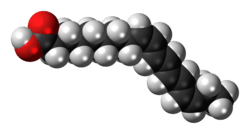alpha-Parinaric acid
α-Parinaric acid is a conjugated polyunsaturated fatty acid. Discovered by Tsujimoto and Koyanagi in 1933,[1] it contains 18 carbon atoms and 4 conjugated double bonds. The repeating single bond-double bond structure of α-parinaric acid distinguishes it structurally and chemically from the usual "methylene-interrupted" arrangement of polyunsaturated fatty acids that have double-bonds and single bonds separated by a methylene unit (−CH2−). Because of the fluorescent properties conferred by the alternating double bonds, α-parinaric acid is commonly used as a molecular probe in the study of biomembranes.
 | |
 | |
| Names | |
|---|---|
| IUPAC name
(9Z,11E,13E,15Z)-octadeca-9,11,13,15-tetraenoic acid | |
| Other names
cis-parinaric acid α-parinaric acid | |
| Identifiers | |
3D model (JSmol) |
|
| ChEBI | |
| ChemSpider | |
PubChem CID |
|
| UNII | |
| |
| |
| Properties | |
| C18H28O2 | |
| Molar mass | 276.41372 |
| Melting point | 85 to 86 °C (185 to 187 °F; 358 to 359 K) |
Except where otherwise noted, data are given for materials in their standard state (at 25 °C [77 °F], 100 kPa). | |
| Infobox references | |
Natural sources
α-Parinaric acid occurs naturally in the seeds of the makita tree (Parinari laurina), a tree found in Fiji and other Pacific islands. Makita seeds contain about 46% α-parinaric acid, 34% α-eleostearic acid as major components, with lesser amounts of saturated fatty acids, oleic acid and linoleic acid.[2] α-Parinaric acid is also found in the seed oil of Impatiens balsamina, a member of the family Balsaminaceae. The major fatty acids of Impatiens balsamina are 4.7% palmitic acid, 5.8% stearic acid, 2.8% arachidic acid, 18.3% oleic acid, 9.2% linoleic acid, 30.1% linolenic acid and 29.1% α-parinaric acid.[3] It is also present in the fungus Clavulina cristata,[4] and the plant Sebastiana brasiliensis (family Euphorbiaceae).[5]
Synthesis
Biosynthesis
The biochemical mechanism by which α-parinaric acid is formed in the plant Impatiens balsamina was elaborated using techniques of molecular biology. The enzyme responsible for the creation of the conjugated double bonds was identified using expressed sequence tags, and called a "conjugase". This enzyme is related to the family of fatty acid desaturase enzymes responsible for putting double bonds into fatty acids.[6]
Chemical synthesis
α-Parinaric acid may be synthesized chemically using α-linoleic acid as a starting compound. This synthesis enables the transformation of 1,4,7-octatriene methylene-interrupted cis double bonds of naturally occurring polyunsaturated fatty acids to 1,3,5,7-octatetraenes in high yield.[7] More recently (2008), Lee et al. reported a simple and efficient chemical synthesis using a modular design method called iterative cross-coupling.[8]
Uses
Membrane probes
Both the alpha and beta (all trans) isomers of parinaric acid are used as molecular probes of lipid-lipid interactions, by monitoring phase transitions in bilayer lipid membranes.[9] α-Parinaric acid was shown to integrate normally into the phospholipid bilayer of mammalian cells,[10] nervous tissue,[11] with minimal effects on the biophysical properties of the membrane. Molecular interactions with neighboring membrane lipids will affect the fluorescence of α-parinaric acid in predictable ways, and the subsequent subtle changes in energy intensities may be measured spectroscopically.
Researchers have put α-parinaric to good use in the study of membrane biophysics. For example, it was used to help establish the existence of a "fluidity gradient" across the membrane bilayer of some tumor cells ― the inner monolayer of the membrane is less fluid than the outer monolayer.[12]
Lipid-protein interactions
α-Parinaric acid is also used as a chromophore to study interactions between membrane proteins and lipids. Because of the similarity of α-parinaric acid to normal membrane lipids, it has minimal perturbing influence.[13] By measuring shifts in the absorption spectrum, enhancement of α-parinaric acid fluorescence, induced circular dichroism, and energy transfer between tryptophan amino acids in the protein and the bound chromophore, information may be gleaned about the molecular interactions between protein and lipid.[13] For example, this technique is used to investigate how fatty acids bind to serum albumin (a highly abundant blood protein),[14][15] lipid transport processes including structural characterization of lipoproteins,[16] and phospholipid-transfer proteins.[17]
Clinical uses
The concentrations of fatty acids in blood serum or plasma can be measured using α-parinaric acid, which will compete for binding sites on serum albumin.[18]
Food chemistry
α-Parinaric acid has been used to study the hydrophobicity and foaming characteristics of food proteins,[19][20] as well as the foam stability of beer.[21] In this latter research, α-parinaric acid was used in a fluorescent assay to assess the lipid–binding potential of the proteins in the beer, as these proteins help protect beer from foam–reducing medium– and long–chain fatty acids.
Cytotoxic effects on tumor cells
α-Parinaric acid is cytotoxic to human leukemia cells in cell culture at concentrations of 5 μM or less, by sensitizing the tumor cells to lipid peroxidation, the process where free radicals react with electrons from cell membrane lipids, resulting in cell damage.[22] It is similarly cytotoxic to malignant gliomas grown in cell culture.[23] Normal (non-tumorous) astrocytes grown in culture are far less sensitive to the cytotoxic effects of α-parinaric acid.[23] This preferential toxicity towards tumor cells is due to a differential regulation of c-Jun N-terminal kinase, and forkhead transcription factors between malignant and normal cells.[24]
References
- Tsujimoto M, Koyanagi H. (1933). New unsaturated acid in the kernel oil of "akarittom", "Parinarium laurinum". I. Kogyo Kagaku Zasshi 36 (Suppl): 110–113.
- Hilditch TP et al. (1964). The Chemical Constitution of Natural Fats, Fourth Edition. pg. 253.
- Gunstone F.D. (1996). Fatty Acid and Lipid Chemistry. Berlin: Springer Verlag. p. 10. ISBN 0-8342-1342-7.
- Endo S, Zhiping G, Takagi T. (1991). Lipid components of seven species of Basidiomycotina and three species of Ascomycotina. Journal of the Japan Oil Chemists' Society 40(7): 574–577.
- Spitzer V, Tomberg W, Zucolotto M. (1996). Identification of alpha-parinaric acid in the seed oil of Sebastiana brasiliensis Sprengel (Euphorbiaceae). Journal of the American Oil Chemists' Society 73(5): 569–573.
- Cahoon EB, Carlson TJ, Ripp KG, Schweiger BJ, Cook GA, Hall SE, Kinney AJ (October 1999). "Biosynthetic origin of conjugated double bonds: production of fatty acid components of high-value drying oils in transgenic soybean embryos". Proc. Natl. Acad. Sci. U.S.A. 96 (22): 12935–40. doi:10.1073/pnas.96.22.12935. PMC 23170. PMID 10536026.
- Kuklev DV, Smith WL (September 2004). "Synthesis of four isomers of parinaric acid". Chem. Phys. Lipids. 131 (2): 215–22. doi:10.1016/j.chemphyslip.2004.06.001. PMID 15351273.
- Lee SJ, Gray KC, Paek JS, Burke MD (January 2008). "Simple, efficient, and modular syntheses of polyene natural products via iterative cross-coupling". J. Am. Chem. Soc. 130 (2): 466–8. doi:10.1021/ja078129x. PMC 3107126. PMID 18081295.
- Sklar LA, Hudson BS, Simoni RD (May 1975). "Conjugated polyene fatty acids as membrane probes: preliminary characterization". Proc. Natl. Acad. Sci. U.S.A. 72 (5): 1649–53. doi:10.1073/pnas.72.5.1649. PMC 432600. PMID 1057769.
- Rintoul DA, Simoni RD (November 1977). "Incorporation of a naturally occurring fluorescent fatty acid into lipids of cultured mammalian cells". J. Biol. Chem. 252 (22): 7916–8. PMID 914848.
- Harris WE, Stahl WL (December 1983). "Incorporation of cis-parinaric acid, a fluorescent fatty acid, into synaptosomal phospholipids by an acyl-CoA acyltransferase". Biochim. Biophys. Acta. 736 (1): 79–91. doi:10.1016/0005-2736(83)90172-4. PMID 6580918.
- Schroeder F (November 1978). "Differences in fluidity between bilayer halves of tumour cell plasma membranes". Nature. 276 (5687): 528–30. doi:10.1038/276528a0. PMID 723938.
- Sklar LA, Hudson BS, Simoni RD (November 1977). "Conjugated polyene fatty acids as fluorescent probes: binding to bovine serum albumin". Biochemistry. 16 (23): 5100–8. doi:10.1021/bi00642a024. PMID 911814.
- Berde CB, Hudson BS, Simoni RD, Sklar LA (January 1979). "Human serum albumin. Spectroscopic studies of binding and proximity relationships for fatty acids and bilirubin". J. Biol. Chem. 254 (2): 391–400. PMID 216673.
- Keuper HJK, Klein RA, Spener F. (1985). Spectroscopic investigations on the binding site of bovine hepatic fatty-acid binding protein: evidence for the existence of a single binding site for two fatty-acid molecules. Chemistry and Physics of Lipids 38(1–2): 159–174.
- Ben-Yashar V, Barenholz Y (November 1991). "Characterization of the core and surface of human plasma lipoproteins. A study based on the use of five fluorophores". Chem. Phys. Lipids. 60 (1): 1–14. doi:10.1016/0009-3084(91)90009-Z. PMID 1813177.
- Kasurinen J, van Paridon PA, Wirtz KW, Somerharju P (September 1990). "Affinity of phosphatidylcholine molecular species for the bovine phosphatidylcholine and phosphatidylinositol transfer proteins. Properties of the sn-1 and sn-2 acyl binding sites". Biochemistry. 29 (37): 8548–54. doi:10.1021/bi00489a007. PMID 2271538.
- Berde CB, Kerner JA, Johnson JD. (1980). Use of the conjugated polyene fatty-acid parinaric-acid in assaying fatty-acids in serum or plasma. Clinical Chemistry 26(8): 1173–1177.
- Townsend A-A, Nakai S. (1983). Relationships between hydrophobicity and foaming characteristics of food proteins. Journal of Food Science 48(2): 588–594.
- Zhu H, Damodaran S. (1994). Heat-induced conformational changes in whey protein isolate and its relation to foaming properties. Journal of Agricultural and Food Chemistry 42(4): 846–855.
- Cooper DJ, Husband FA, Mills EN, Wilde PJ (December 2002). "Role of beer lipid-binding proteins in preventing lipid destabilization of foam". J. Agric. Food Chem. 50 (26): 7645–50. doi:10.1021/jf0203996. PMID 12475284.
- Cornelius AS, Yerram NR, Kratz DA, Spector AA (November 1991). "Cytotoxic effect of cis-parinaric acid in cultured malignant cells". Cancer Res. 51 (22): 6025–30. PMID 1933865.
- Traynelis VC, Ryken TC, Cornelius AS (September 1995). "Cytotoxicity of cis-parinaric acid in cultured malignant gliomas". Neurosurgery. 37 (3): 484–9. doi:10.1097/00006123-199509000-00017. PMID 7501114.
- Zaheer A, Sahu SK, Ryken TC, Traynelis VC (January 2007). "Cis-parinaric acid effects, cytotoxicity, c-Jun N-terminal protein kinase, forkhead transcription factor and Mn-SOD differentially in malignant and normal astrocytes". Neurochem. Res. 32 (1): 115–24. doi:10.1007/s11064-006-9236-2. PMID 17160503.